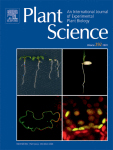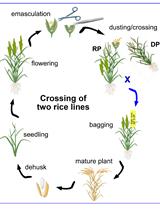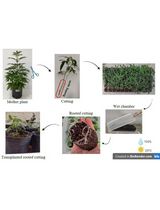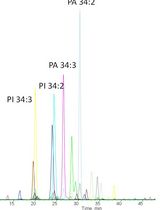- EN - English
- CN - 中文
Chromatographic Analysis for Targeted Metabolomics of Antioxidant and Flavor-Related Metabolites in Tomato
番茄抗氧化剂和风味相关代谢产物靶向代谢组学的色谱分析
发布: 2021年03月05日第11卷第5期 DOI: 10.21769/BioProtoc.3929 浏览次数: 4793
评审: Carlos Ignacio LescanoAvinash Chandra PandeyAnonymous reviewer(s)
Abstract
Targeted metabolomics is a useful approach to evaluate crop breeding studies. Antioxidant and flavor-related traits are of increasing interest and are considered quality traits in tomato breeding. The present study presents chromatographic methods to study antioxidants (carotenoids, vitamin C, vitamin E, phenolic compounds, and glutathione) and flavor-related characters (sugars and organic acids) in tomato. Two different extraction methods (for polar and apolar entities) were applied to isolate the targeted compounds. The extraction methods developed in this work were time and cost-effective since no further purification was needed. Carotenoids, vitamin C, glutathione, and phenolic acids were analyzed by HPLC-PDA using a RP C18 column at an appropriate wavelength for each compound. Vitamin E and sugars were analyzed by HPLC with RP C18 and NH2 columns and detected by FLD and RI detectors, respectively. In addition, organic acids were analyzed with GC-FID using a Rtx 5DA column after derivatization with MSTFA. As a result, sensitive analytical methods to quantify important plant metabolites were developed and are described herein. These methods are not only applicable in tomato but are also useful to characterize other species for flavor-related and antioxidant compounds. Thus, these protocols can be used to guide selection in crop breeding.
Keywords: HPLC (高效液相色谱法)Background
Metabolomics is an applied biochemical approach which has gained attention for its potential to aid crop breeding studies. In tomato breeding, both antioxidant and flavor-related metabolites are of increasing interest because of consumer preferences for improved crop quality. Humans cannot synthesize antioxidant molecules themselves; therefore, these molecules must be provided by the external daily diet (Lobo et al., 2010). Flavor is a complex trait that also affects the consumer marketability of tomato (Kader, 2008). Thus, the quantification of these traits is important. Because the metabolome is complex and consists of a wide variety of compounds including lipid-soluble metabolites, aqueous polar metabolites, stable and unstable metabolites, as well as acidic and basic metabolites, many methods for both extraction and detection of plant metabolites are available. These methods encompass a range of different chromatographic techniques with different extraction methods depending on the type of metabolite. In the literature, different techniques including ultrasonication (Tan et al., 2021), supercritical CO2 extraction (Pellicanò et al., 2020), water-induced hydrocolloidal complexation (Nagarajan et al., 2020), and solid phase extraction (Figueira et al., 2017) have been used to extract antioxidant molecules or flavor-related metabolites. Most of these extraction methods include many steps, sometimes require special chemicals and equipment, or entail pre-purification procedures. As a result, many of these methods are expensive and time consuming. Similarly, different chromatographic techniques have been used to quantify metabolites. The most commonly used method for both targeted (Dumont et al., 2020, Tohge et al., 2020) and untargeted metabolic profiling (Capanoglu et al., 2008, Treutler et al., 2016) is mass spectrophotometry coupled with either liquid or gas chromatography. The nuclear magnetic resonance technique (NMR) can also be used for metabolomics (Ingallina et al., 2020, Masetti et al., 2020). These methods not only require very expensive equipment but also require expertise. An alternative is the use of spectrophotometric methods which can be applied to evaluate lycopene content (Migalatev, 2017), total antioxidant capacity (Martínez et al., 2020), total phenolic acids and flavonoid content (Alenazi et al., 2020). Although spectrophotometric methods are easy and cheap, they are not as sensitive as chromatographic methods. Moreover, quantification of individual molecules such as specific phenolic acids or sugars is not feasible.
Given the limitations of the available extraction and analysis protocols, the current work was designed to establish rapid, easy and relatively cheap extraction methods for two groups of compounds, polar and apolar metabolites. In addition, cheap, easy and sensitive chromatographic methods (HPLC and GC) were developed to detect and quantify the different types of antioxidant and flavor-related metabolites. Apolar extracts were used for analysis of carotenoids with a HPLC method modified from those described by Ishida et al. (2001) and Serino et al. (2009). Polar extracts were used for the analysis of vitamin C, vitamin E, phenolic acids, reduced and oxidized glutathione, and sugars using HPLC. The HPLC methods for these compounds were modified from those described in previous studies for vitamin C (Li and Chen, 2001a and 2001b), vitamin E (Turner and Burri, 2012; Bakre et al., 2015), phenolic acids (Gómez-Alonso et al., 2007), glutathione (Khan et al., 2011), and sugars (Petkova et al., 2013). Organic acids were also detected from polar extracts using a GC method modified from those described in previous studies (Roessner et al., 2001; Namgung et al., 2010). All protocols were developed using fully ripe fruits (at market stage) from a tomato inbred backcross line population as samples. This interspecific population was derived from S. lycopersicum by S. pimpinellifolium cross (Celik et al., 2017) and provided sufficient variation for the metabolites of interest to test the new protocols.
Materials and Reagents
Plant Material
An interspecific IBL (inbred backcross line) population (BC2F6) derived from the cross S. lycopersicum cv. Tueza (recurrent parent) × S. pimpinellifolium (LA1589) (donor parent) was used as plant material. This population was developed in previous studies and is described more fully in the literature (Celik et al., 2017; Gürbüz Çolak et al., 2020a and 2020b). Tueza is a cultivated fresh market tomato line with large (150-160 g), red, slightly flattened round fruits. LA1589 is a wild tomato accession with small (0.8-1 g), red, round fruits. The IBL population and parents were grown in the greenhouse in Antalya, Turkey. Ten plants per genotype were grown in double rows with 140 and 30 cm between wide and narrow rows, respectively. Plants were spaced at 40 cm intervals within rows. For basal fertilization, 500 kg 15:15:15 (N:P:K) fertilizer and 50 t of composted manure were applied per ha. Drip irrigation was used with fertigation (1.4 dS m-1 EC value) at each irrigation using 1-2-1 fertilizer until first fruit set, 2-1-1 fertilizer until first fruit ripening and 1-1-2 fertilizer after first fruit ripening.
Major Ingredients
C18 column (GL Sciences, catalog number: 5020-03946 )
NH2 column (GL Sciences, catalog number: 5020-05546 )
RTx 5DA column (Restek, catalog number: 10523 )
Syringe (BD, Emerald, catalog number: 307742 )
Syringe filter (Millipore, catalog number: Z227412 )
Polyamide membrane filter (45 µm, 47 mm) (Sartorius, catalog number: 25006-47-N )
Acetonitrile (VWR, catalog number: 97065 )
Ammonium dihydrogen phosphate (Merck, catalog number: 1.01126.0500 )
Butylated hydroxytoluene (BHT) (Sigma-Aldrich, catalog number: W218405 )
Chloroform (VWR, catalog number: JT9175 )
Dichloromethane (VWR, catalog number: BDH23373 )
Ethyl acetate (VWR, catalog number: JT9282 )
Hexane (VWR, catalog number: BDH24575 )
Methanol (VWR, catalog number: BDH20864 )
Methoxamine hydrochloride (Sigma-Aldrich, catalog number: M6524 )
N-Methyl-N-(trimethylsilyl) trifluoroacetamide (MSTFA) (Sigma-Aldrich, catalog number: 69479 )
Ortho-phosphoric acid (Merck, catalog number: 100573 )
Potassium dihydrogen phosphate KH2PO4 (Riedel-de Haën, catalog number: 04243)
Pyridine (Sigma-Aldrich, catalog number: 270970 )
Triethylamine (Merck, catalog number: 8083520500 )
Trifluoroacetic acid (Sigma-Aldrich, catalog number: T6508 )
0.1 M KH2PO4, pH = 7.0 (see Recipes)
0.05% Trifluoroacetic acid(aq) (see Recipes)
Chemicals used as control molecules
β-carotene (Carl Roth, catalog number: 5669.1 )
Apigenin (Applichem, catalog number: A3641 )
Caffeic acid (Sigma-Aldrich, catalog number: C0625 )
Catechin (Applichem, catalog number: A4325 )
Chlorogenic acid (Sigma-Aldrich, catalog number: 00500590)
Chrysin (Fluka, catalog number: 9582 )
Cinnamic acid (Sigma-Aldrich, catalog number: W228826 )
Citric acid (Carl Roth, catalog number: X863.1 )
Coumaric acid (Carl Roth, catalog number: 9906.1 )
Cyanidine (Carl Roth, catalog number: 4545.1 )
Epicatechin (Applichem, catalog number: A3424 )
Epigallocatechin (Applichem, catalog number: A2010 )
Ferulic acid (Sigma-Aldrich, catalog number: 128708 )
Fructose (Sigma-Aldrich, catalog number: F0127 )
Fumaric acid (Sigma-Aldrich, catalog number: 47910 )
Gallic acid (Sigma-Aldrich, catalog number: 91215 )
Glucose (Sigma-Aldrich, catalog number: G8270 )
Hydroxybenzoic acid (Sigma-Aldrich, catalog number: W398608 )
Lactic acid (Sigma-Aldrich, catalog number: L1750 )
Lutein (Applichem, catalog number: A1283 )
Luteolin (Applichem, catalog number: A3424 )
Lycopene (Carl Roth, catalog number: 5670.1 )
Malic acid (Carl Roth, catalog number: 8684.1 )
Malvidin (Applichem, catalog number: A8720 )
Myricetin (Carl Roth, catalog number: 6461.1 )
Oxidized glutathione (Sigma-Aldrich, catalog number: G4376 )
Pelargonidin (Carl Roth, catalog number: 4540.1 )
Peonidin (R&D, catalog number: 0 942 )
Pterostilben (Sigma-Aldrich, catalog number: P1499 )
Quercetin (Applichem, catalog number: A3415 )
Reduced glutathione (Sigma-Aldrich, catalog number: G4251 )
Resveratrol (Sigma-Aldrich, catalog number: R5010 )
Salicyclic acid (Sigma-Aldrich, catalog number: W398500 )
Shikimic acid (Carl Roth, catalog number: 7305.2 )
Sinapic acid (Carl Roth, catalog number: 5317.1 )
Sucrose (Sigma-Aldrich, catalog number: S5016 )
Syringic acid (Carl Roth, catalog number: 5361.1 )
Tartaric acid (Carl Roth, catalog number: K302.1 )
Vanillic acid (Carl Roth, catalog number: 3685.1 )
Vitamin C (Sigma-Aldrich, catalog number: A5960 )
Vitamin E (Sigma-Aldrich, catalog number: T3251 )
Zeaxanthin (Carl Roth, catalog number: 5672.2 )
Extraction solvent 1 (see Recipes)
Extraction solvent 2: Chloroform: methanol: water (1:3:1, v:v:v) (see Recipes)
Equipment
-80 °C freezer
Analytical balance (Mettler Toledo, model: AB54-S )
Centrifuge (Beckman Coulter, model: Allegra X-15R )
Centrifuge (Thermo Scientific, model: SL 16 )
GC/FID (Shimadzu, model: GC 2010 plus ) with RTx 5DA column (0.25 mm × 0.25 mm × 30 m) (Restek; catalog number: 10523 )
HPLC (Shimadzu, model: LC20-AT ; refractive index (RI) detector model: RID 10A; photodiode array (PDA) detector model: SPD M20A; fluorescence detector model: RF 20A) with C18 column (5 µm-25 × 4.6 mm) (GL Sciences, catalog number: 5020-03946 ) and NH2 column (5 µm-25 × 4.6 mm) GL Sciences; catalog number: 5020-05546 )
Knife grinder (Retsch, model: GM200 )
Lyophilizer (Christ, model: Epsilon 1-4 LSC )
Orbital shaker (IKA, model: KS260 )
Vacuum evaporator (Labconco, model: Centrivap )
Vacuum filtration (Do-Chrom, model: FB01 )
Software
LC Solution (Shimadzu, https://www.shimadzu.com/an/lcms/opensolution/opensol4.html)
GC Solution (Shimadzu, https://www.shimadzu.com/an/gc/advflowtech/sw-dl.html)
Procedure
文章信息
版权信息
© 2021 The Authors; exclusive licensee Bio-protocol LLC.
如何引用
Gürbüz Çolak, N., Eken, N. T., Frary, A. and Doganlar, S. (2021). Chromatographic Analysis for Targeted Metabolomics of Antioxidant and Flavor-Related Metabolites in Tomato. Bio-protocol 11(5): e3929. DOI: 10.21769/BioProtoc.3929.
分类
植物科学 > 植物生物化学 > 代谢物
植物科学 > 植物育种
生物化学 > 糖类
您对这篇实验方法有问题吗?
在此处发布您的问题,我们将邀请本文作者来回答。同时,我们会将您的问题发布到Bio-protocol Exchange,以便寻求社区成员的帮助。
提问指南
+ 问题描述
写下详细的问题描述,包括所有有助于他人回答您问题的信息(例如实验过程、条件和相关图像等)。
Share
Bluesky
X
Copy link












